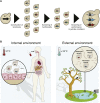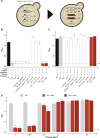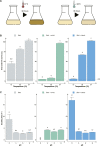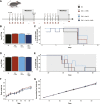Biocontainment strategies for in vivo applications of Saccharomyces boulardii
- PMID: 36890914
- PMCID: PMC9986445
- DOI: 10.3389/fbioe.2023.1136095
Biocontainment strategies for in vivo applications of Saccharomyces boulardii
Abstract
The human gastrointestinal tract is a complex and dynamic environment, playing a crucial role in human health. Microorganisms engineered to express a therapeutic activity have emerged as a novel modality to manage numerous diseases. Such advanced microbiome therapeutics (AMTs) must be contained within the treated individual. Hence safe and robust biocontainment strategies are required to prevent the proliferation of microbes outside the treated individual. Here we present the first biocontainment strategy for a probiotic yeast, demonstrating a multi-layered strategy combining an auxotrophic and environmental-sensitive strategy. We knocked out the genes THI6 and BTS1, causing thiamine auxotrophy and increased sensitivity to cold, respectively. The biocontained Saccharomyces boulardii showed restricted growth in the absence of thiamine above 1 ng/ml and exhibited a severe growth defect at temperatures below 20°C. The biocontained strain was well tolerated and viable in mice and demonstrated equal efficiency in peptide production as the ancestral non-biocontained strain. In combination, the data support that thi6∆ and bts1∆ enable biocontainment of S. boulardii, which could be a relevant chassis for future yeast-based AMTs.
Keywords: S boulardii; biocontainment; biosafety; engineered microbes; gut micobiome; probiotic yeast.
Copyright © 2023 Hedin, Kruse, Vazquez-Uribe and Sommer.
Conflict of interest statement
All authors are inventors on a patent filed by DTU on the Biocontainment strategy.
Figures





Similar articles
-
Cold Exposure and Oral Delivery of GLP-1R Agonists by an Engineered Probiotic Yeast Strain Have Antiobesity Effects in Mice.ACS Synth Biol. 2023 Nov 17;12(11):3433-3442. doi: 10.1021/acssynbio.3c00455. Epub 2023 Oct 12. ACS Synth Biol. 2023. PMID: 37827516 Free PMC article.
-
Microbiome Engineering Using Probiotic Yeast: Saccharomyces boulardii and the Secreted Human Lysozyme Lead to Changes in the Gut Microbiome and Metabolome of Mice.Microbiol Spectr. 2023 Aug 17;11(4):e0078023. doi: 10.1128/spectrum.00780-23. Epub 2023 Jul 12. Microbiol Spectr. 2023. PMID: 37436157 Free PMC article.
-
Functional heterologous protein expression by genetically engineered probiotic yeast Saccharomyces boulardii.PLoS One. 2014 Nov 12;9(11):e112660. doi: 10.1371/journal.pone.0112660. eCollection 2014. PLoS One. 2014. PMID: 25391025 Free PMC article.
-
Saccharomyces boulardii: What Makes It Tick as Successful Probiotic?J Fungi (Basel). 2020 Jun 4;6(2):78. doi: 10.3390/jof6020078. J Fungi (Basel). 2020. PMID: 32512834 Free PMC article. Review.
-
Yeasts as probiotics: Mechanisms, outcomes, and future potential.Fungal Genet Biol. 2020 Apr;137:103333. doi: 10.1016/j.fgb.2020.103333. Epub 2020 Jan 7. Fungal Genet Biol. 2020. PMID: 31923554 Review.
Cited by
-
Saccharomyces boulardii promoters for control of gene expression in vivo.Microb Cell Fact. 2024 Jan 7;23(1):16. doi: 10.1186/s12934-023-02288-8. Microb Cell Fact. 2024. PMID: 38185666 Free PMC article.
-
Targeted delivery of the probiotic Saccharomyces boulardii to the extracellular matrix enhances gut residence time and recovery in murine colitis.Nat Commun. 2024 May 6;15(1):3784. doi: 10.1038/s41467-024-48128-0. Nat Commun. 2024. PMID: 38710716 Free PMC article.
-
Recent advances in single-cell engineered live biotherapeutic products research for skin repair and disease treatment.NPJ Biofilms Microbiomes. 2023 Dec 8;9(1):95. doi: 10.1038/s41522-023-00463-8. NPJ Biofilms Microbiomes. 2023. PMID: 38065982 Free PMC article. Review.
-
Phage lysins for intestinal microbiome modulation: current challenges and enabling techniques.Gut Microbes. 2024 Jan-Dec;16(1):2387144. doi: 10.1080/19490976.2024.2387144. Epub 2024 Aug 6. Gut Microbes. 2024. PMID: 39106212 Free PMC article. Review.
-
Small intestine vs. colon ecology and physiology: Why it matters in probiotic administration.Cell Rep Med. 2023 Sep 19;4(9):101190. doi: 10.1016/j.xcrm.2023.101190. Epub 2023 Sep 7. Cell Rep Med. 2023. PMID: 37683651 Free PMC article. Review.
References
Grants and funding
LinkOut - more resources
Full Text Sources
Other Literature Sources

